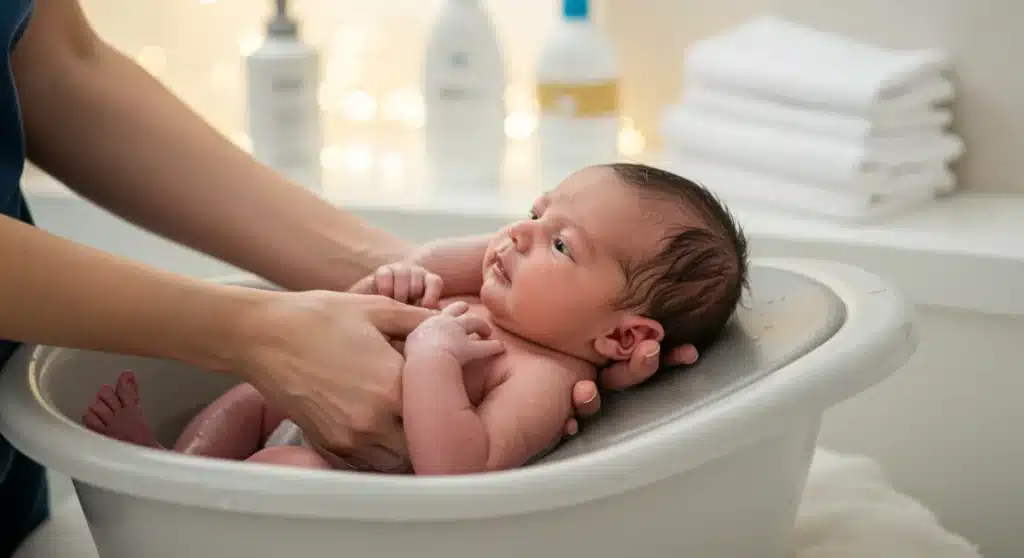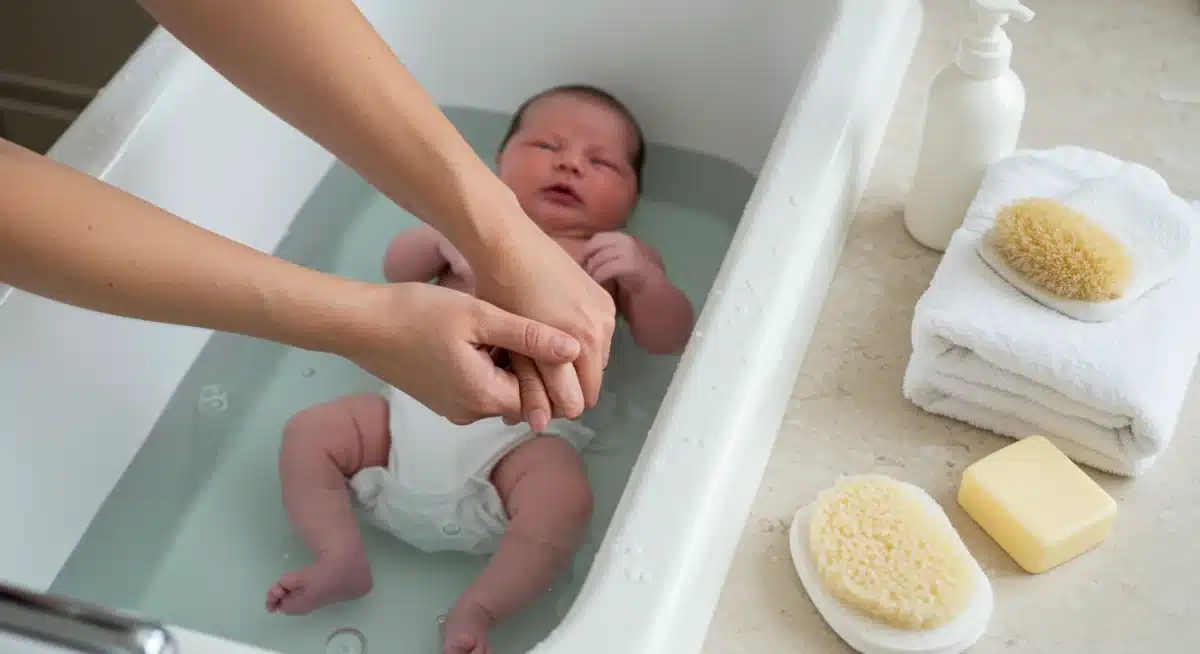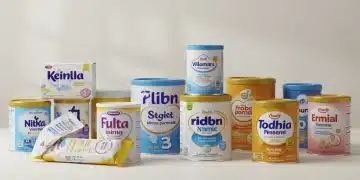Newborn Bathing Basics: Complete Guide for First-Time Parents

Advertisement
Mastering newborn bathing basics is crucial for first-time parents, ensuring a safe, hygienic, and enjoyable experience for their little one through proper preparation and gentle techniques.
Embarking on the journey of parenthood brings immense joy, countless questions, and a steep learning curve, especially when it comes to fundamental care routines. Among these, mastering newborn bathing basics often tops the list of anxieties for new parents. The thought of handling a tiny, slippery infant in water can seem daunting, but with the right knowledge and preparation, bath time can transform into a cherished bonding ritual, promoting both hygiene and relaxation for your baby.
Understanding Your Newborn’s First Baths
The initial baths for a newborn are significantly different from those for an older infant or child. Before the umbilical cord stump falls off, typically within one to three weeks, sponge baths are the recommended method. This approach minimizes the risk of infection and keeps the umbilical area dry, promoting faster healing. Once the stump has detached and the area is dry, you can transition to a traditional baby tub bath, but even then, gentleness and careful handling remain paramount.
Advertisement
It’s important to remember that newborns don’t need daily baths. Their skin is incredibly delicate and can dry out easily. Two to three baths per week are usually sufficient, with spot cleaning for messes in between. Over-bathing can strip their skin of natural oils, leading to dryness or irritation. Always prioritize your baby’s comfort and safety during this new experience.
Sponge Bath Essentials and Technique
For a sponge bath, gather all your supplies beforehand. This includes a soft washcloth, two basins of warm water (one for washing, one for rinsing), mild baby soap (if desired, though plain water is often sufficient for newborns), a clean diaper, and a soft towel. Choose a warm room with no drafts to keep your baby comfortable.
- Lay your baby on a soft, flat surface, such as a changing table or a towel on the floor.
- Keep your baby wrapped in a towel, exposing only the body part you are currently washing.
- Gently wipe their face, starting with the eyes (using a separate cotton ball or corner of the washcloth for each eye, wiping from the inner corner outwards).
- Clean behind the ears, neck folds, and underarms.
- Wash the diaper area thoroughly, always wiping front to back for girls.
The key to a successful sponge bath is efficiency and warmth. Work quickly but gently, ensuring your baby remains covered as much as possible to prevent chills. This method ensures cleanliness while safeguarding the sensitive umbilical area.
Advertisement
Transitioning to Tub Baths
Once the umbilical stump has healed, transitioning to a baby tub bath can be an exciting milestone. Start with a small, infant-specific tub that supports your baby’s head and body, preventing them from slipping. Ensure the room is warm and all bath supplies are within arm’s reach. Never leave your baby unattended, even for a second.
The transition should be gradual, allowing your baby to adjust to the sensation of being immersed in water. Keep the first tub baths short, focusing on making it a positive and soothing experience. Your calm demeanor will help your baby feel secure and enjoy the new routine.
Understanding the nuances of early bathing, from sponge baths to the first tub experiences, sets a solid foundation for your newborn’s hygiene and comfort. Patience, preparation, and a gentle touch are your best allies in making bath time a joyful part of your daily routine.
Setting Up a Safe and Soothing Bath Environment
Creating the right environment for your baby’s bath is just as important as the bathing technique itself. A safe, warm, and soothing space can make all the difference, transforming a potentially stressful event into a relaxing ritual for both parent and child. This involves careful consideration of room temperature, water temperature, and the organization of your bath supplies.
The goal is to minimize any potential hazards while maximizing comfort. A well-prepared bath area means you won’t have to leave your baby’s side for anything, ensuring continuous supervision. This proactive approach is fundamental to newborn safety during bath time, preventing accidents before they can occur.
Ideal Room and Water Temperatures
The room where you bathe your newborn should be comfortably warm, ideally between 75-80°F (24-27°C), to prevent your baby from getting cold. Drafts can cause a baby to chill quickly, so close windows and doors. For the bath water, the temperature should be lukewarm, around 98-100°F (37-38°C). Always test the water with your elbow or a bath thermometer before placing your baby in it. What feels warm to your hand might be too hot for your baby’s delicate skin. Never put your baby into running water, as the temperature can change rapidly.
- Room Temperature: Maintain 75-80°F (24-27°C).
- Water Temperature: Aim for 98-100°F (37-38°C).
- Testing Method: Use your elbow or a thermometer.
- Safety First: Never place baby in running water.
Maintaining these temperatures ensures your baby stays cozy and content throughout the bath, reducing fussiness and making the experience more enjoyable for everyone involved.
Essential Bath Supplies Within Reach
Before you even begin to fill the tub, gather everything you’ll need and place it within arm’s reach. This prevents you from having to turn away from your baby, even for a second. Essential supplies include a baby bathtub, a soft washcloth, mild, tear-free baby soap and shampoo, a clean diaper, a soft hooded towel, and a change of clothes.
Consider having a small, portable container for these items to keep them organized and ready for each bath. This practice not only enhances safety but also streamlines the bathing process, allowing you to focus entirely on your baby. Having everything prepared beforehand contributes significantly to a calm and efficient bath time routine, making it a positive experience for both you and your newborn.

Step-by-Step Guide to Bathing Your Newborn
Bathing your newborn doesn’t have to be a source of stress. With a clear, step-by-step approach, you can confidently navigate this essential routine. The process involves gentle handling, methodical cleaning, and immediate comfort post-bath, all designed to ensure your baby’s safety and well-being. This guide will walk you through each stage, from the initial preparation to the final cuddle, ensuring a smooth and enjoyable experience for both of you.
Remember, consistency helps. Establishing a routine around bath time can signal to your baby that it’s time to wind down, making the process more predictable and less overwhelming. Your calm and reassuring presence is the most important tool you have.
Gentle Cleaning Techniques for Head to Toe
Start by gently cleaning your baby’s face with a damp, soft washcloth, without soap. Pay special attention to the eyes, wiping from the inner corner outwards, using a fresh part of the cloth for each eye. Then, move to the scalp. If your baby has hair, use a small amount of tear-free baby shampoo, gently massaging it in and rinsing thoroughly. Cradle your baby’s head and neck with one arm to support them.
Next, move to the body. Using a mild baby soap, gently wash their neck folds, armpits, and groin area, where dirt and moisture can accumulate. Pay attention to creases in the skin. Rinse thoroughly, ensuring no soap residue is left, as this can irritate their delicate skin. Keep the washing quick and efficient to prevent your baby from getting cold.
- Face: Wipe eyes from inner to outer corner.
- Scalp: Use tear-free shampoo, rinse well.
- Body: Focus on folds and creases, rinse thoroughly.
- Support: Always support head and neck.
Throughout this process, maintain a gentle touch and speak softly to your baby, reassuring them with your voice. This helps to create a positive association with bath time, making it a pleasant sensory experience.
Handling Your Baby Safely in Water
Safety is paramount when bathing your newborn. Always keep one hand on your baby to provide constant support and prevent slipping. Their skin becomes very slippery when wet, so a firm but gentle grip is crucial. Use an infant tub that provides good head and neck support, or place a non-slip mat in a larger tub if you’re using one designed for older babies.
Fill the tub with only about 2-3 inches of water – just enough to cover their bottom. Never fill it too high. If you need to add more warm water during the bath, remove your baby from the tub first to avoid any sudden temperature changes or accidental scalding. Your undivided attention is the most important safety measure you can provide during bath time.
By following these steps, you can ensure a safe, clean, and comforting bath experience for your newborn, building confidence and strengthening your bond with each gentle wash.
Choosing the Right Bath Products for Sensitive Skin
Selecting appropriate bath products for your newborn’s sensitive skin is a critical aspect of their care. Their skin barrier is still developing, making it more permeable and susceptible to irritation from harsh chemicals, fragrances, and dyes. Opting for gentle, hypoallergenic, and pH-neutral products can prevent dryness, rashes, and discomfort, ensuring bath time remains a soothing experience. The market is flooded with baby products, making informed choices essential for your little one’s well-being.
It’s not just about what you use, but also what you avoid. Products with long ingredient lists containing unfamiliar chemicals should raise a red flag. Simplicity and natural ingredients, where possible, are often the best approach for delicate newborn skin. Always patch test new products on a small area of skin before full application.
Hypoallergenic and Fragrance-Free Options
When choosing baby soaps and shampoos, prioritize products labeled as hypoallergenic and fragrance-free. Hypoallergenic products are formulated to minimize the risk of allergic reactions, which is crucial for newborns with developing immune systems. Fragrances, even those derived from natural sources, can be irritants for sensitive skin and may even contain phthalates, which are endocrine disruptors.
- Hypoallergenic: Reduces allergy risk.
- Fragrance-Free: Avoids irritants and potential harmful chemicals.
- Dye-Free: Prevents skin discoloration and irritation.
- pH-Neutral: Matches baby’s natural skin pH.
Look for products specifically designed for newborns or sensitive skin, often recommended by pediatricians. Brands that are transparent about their ingredients and undergo rigorous testing are generally a safer bet. Reading reviews from other parents can also offer valuable insights into product effectiveness and gentleness.
Moisturizing After Bathing
After bathing, especially if your baby has dry skin, applying a gentle, fragrance-free moisturizer is highly recommended. The warm water can strip natural oils from the skin, and a good moisturizer helps to replenish hydration and maintain the skin’s barrier function. Apply the moisturizer within a few minutes of taking your baby out of the bath to lock in moisture effectively.
Choose a cream or ointment rather than a lotion, as creams and ointments tend to be thicker and more effective at hydrating. Look for ingredients like ceramides, shea butter, or colloidal oatmeal, known for their soothing and moisturizing properties. Gentle massage during application can also be a wonderful bonding opportunity, further enhancing the positive experience of bath time. This post-bath routine is crucial for keeping your newborn’s skin soft, supple, and healthy.
Common Bath Time Challenges and Solutions
Even with the best preparation, bath time with a newborn can present its unique set of challenges. From a baby who cries at the sight of water to issues like dry skin or cradle cap, knowing how to address these common hurdles can help parents navigate them with confidence. Understanding that every baby is different and adapting your approach is key to transforming potential struggles into manageable moments, ensuring bath time remains a positive experience for your little one.
Patience and flexibility are your greatest assets. What works for one baby might not work for another, so be prepared to try different techniques and observe your baby’s reactions. Your goal is to make bath time as comfortable and stress-free as possible.
Dealing with a Fussy Baby During Bath Time
Some babies simply don’t enjoy baths, and their fussiness can be disheartening for parents. If your baby cries or seems agitated during bath time, consider a few adjustments. First, ensure the room and water temperatures are ideal. A slightly chilly room or water that’s too hot or cold can cause discomfort. Try wrapping your baby in a warm towel and gently lowering them into the water while still partially covered, slowly unwrapping them as they adjust.
Timing can also play a role. Some babies prefer baths when they’re well-fed and rested, while others might enjoy it just before a feeding. Experiment with different times of day to find what works best. Singing softly, talking to your baby, or using bath toys (even for newborns, simple soft toys can be a distraction) can also help create a more positive atmosphere. A warm, calming voice can be incredibly soothing.
Managing Dry Skin and Cradle Cap
Dry skin is common in newborns, especially after bathing. To combat this, limit bath time to 5-10 minutes, use lukewarm water, and avoid harsh soaps. After bathing, gently pat your baby dry instead of rubbing, and immediately apply a thick, fragrance-free moisturizer to lock in hydration. For persistent dry patches, consult your pediatrician, as they might recommend specific products.
Cradle cap, characterized by greasy, yellowish scales on the scalp, is also common and usually harmless. To manage it, gently massage a small amount of baby oil or olive oil onto your baby’s scalp about 15-20 minutes before bath time to loosen the scales. During the bath, use a soft baby brush or comb to gently remove the flakes, then wash the scalp with a mild baby shampoo. Avoid picking at the scales, as this can irritate the skin. Regular, gentle washing and brushing usually clear up cradle cap within a few weeks or months.
By understanding and addressing these common challenges, you can ensure your newborn’s bath time is not only clean but also a calm and nurturing experience, fostering healthy skin and a happy baby.
Making Bath Time a Bonding Experience
Beyond hygiene, bath time offers a unique opportunity for bonding between parents and their newborn. The warmth of the water, the gentle touch, and the undivided attention create a sensory-rich environment that strengthens emotional connections. This dedicated time can become a cherished ritual, fostering a sense of security and love that is vital for your baby’s development. It’s an intimate moment away from distractions, allowing you to fully engage with your little one.
Approaching bath time with intention and presence can transform it from a chore into a profound experience. It’s about more than just getting clean; it’s about connecting, communicating through touch, and creating lasting memories.
Tips for Creating a Relaxing Atmosphere
To enhance the bonding experience, focus on creating a truly relaxing atmosphere. Dim the lights slightly, or use soft, indirect lighting. Play calming music or white noise in the background. Ensure the room is warm and free from drafts. Speak to your baby in a soft, soothing voice throughout the bath, describing what you’re doing and offering words of love and reassurance.
Consider incorporating gentle massage before or after the bath. A warm towel ready for immediate wrapping adds to the comfort. The goal is to engage all of your baby’s senses in a positive way, making them feel secure, loved, and at peace. This careful attention to the environment helps your baby associate bath time with comfort and parental affection.
Engaging Your Baby During the Bath
Even newborns can benefit from engagement during bath time. Maintain eye contact and smile at your baby. Gently splash water on their tummy or feet, observing their reactions. Sing lullabies or talk to them about their day. These interactions stimulate their senses and reinforce the parent-child bond. For slightly older newborns, a simple bath toy, like a soft rubber duck or a floating cup, can provide a focal point for their attention, though interaction with you remains most important.
- Eye Contact: Connect visually with your baby.
- Gentle Splashing: Introduce sensory play.
- Singing/Talking: Soothe and stimulate with your voice.
- Simple Toys: Offer distraction and engagement.
The act of bathing, with its intimate physical contact and focused attention, provides a perfect setting for strengthening your emotional connection. It’s a time to slow down, be present, and revel in the precious moments of early parenthood, transforming a basic necessity into a beautiful bonding opportunity.
Post-Bath Care: Keeping Your Newborn Cozy and Dry
The moments immediately following the bath are just as crucial as the bath itself, focusing on keeping your newborn warm, dry, and comfortable. Rapid temperature changes can make a baby chilly, so having a well-organized post-bath routine is essential. This period is also ideal for further skin care and a final bit of bonding before dressing your baby for rest or play. A smooth transition from water to warmth helps solidify the positive associations with bath time, reinforcing a sense of security and well-being.
Preparation is key here, ensuring everything you need is within arm’s reach before the bath even begins. This minimizes the time your baby spends exposed and maximizes their comfort.
Wrapping and Drying Techniques
As soon as you lift your baby out of the bath, wrap them immediately in a warm, soft hooded towel. The hood helps to keep their head warm, which is important as newborns lose a significant amount of heat from their heads. Gently pat your baby dry, paying special attention to creases and folds, such as under the chin, in the armpits, and in the groin area. Moisture left in these areas can lead to skin irritation or diaper rash.
Avoid vigorous rubbing, as this can be harsh on delicate newborn skin. The goal is to absorb moisture gently but thoroughly. Having a second, dry towel nearby can be useful if the first one becomes too damp. The swift transition from water to a warm, dry towel is critical for preventing chills and maintaining your baby’s comfort.

Moisturizing and Dressing Your Baby
Once your baby is thoroughly dry, it’s the perfect time to apply a gentle, fragrance-free moisturizer, especially if they have dry skin. This helps to lock in moisture and protect their delicate skin barrier. Apply the moisturizer with soft, circular motions, turning it into another opportunity for gentle touch and bonding. This routine is particularly beneficial in preventing and managing common newborn skin issues.
- Moisturize: Apply fragrance-free lotion or cream.
- Diaper: Use a clean, dry diaper.
- Dress: Choose soft, comfortable clothing.
- Swaddle (Optional): For extra warmth and security.
After moisturizing, put on a clean diaper and dress your baby in soft, comfortable clothing suitable for the room temperature. Many parents choose to swaddle their newborn after a bath, as it mimics the snugness of the womb and can promote relaxation and sleep. This entire post-bath routine, from drying to dressing, should be a calm and loving process, reinforcing the positive associations your baby has with bath time and preparing them for a soothing rest.
Troubleshooting and When to Call the Pediatrician
While most newborn bathing experiences are straightforward, it’s natural for parents to encounter questions or concerns. Knowing when to troubleshoot minor issues at home and when to seek professional advice from your pediatrician is crucial. Being informed empowers you to make the best decisions for your baby’s health and comfort, ensuring that any potential problems are addressed promptly and effectively. Trusting your parental instincts is often the first step in recognizing when something might be amiss.
This section aims to provide guidance on common concerns that might arise during or after bath time, offering peace of mind and clear direction for new parents.
Minor Skin Irritations and Rashes
Newborn skin is incredibly delicate and prone to minor irritations. Small red bumps, dry patches, or mild rashes can appear. Often, these are harmless and resolve on their own with gentle care. Ensure you are using hypoallergenic, fragrance-free bath products and moisturizing regularly. If a rash appears, try to identify any new products or detergents that might have been introduced. Keeping the skin clean and dry, especially in folds, can prevent many issues.
However, if a rash spreads rapidly, becomes blistered, oozes, is accompanied by fever, or seems to be causing your baby significant discomfort, it’s time to contact your pediatrician. They can accurately diagnose the cause and recommend appropriate treatment. While many rashes are benign, some can indicate underlying conditions that require medical attention.
Signs of Infection or Allergic Reaction
Although rare, signs of infection or an allergic reaction related to bath time products or practices warrant immediate medical attention. An umbilical stump that becomes red, swollen, or produces foul-smelling discharge needs to be checked by a doctor. Similarly, if your baby develops a fever, becomes lethargic, or shows signs of severe discomfort after a bath, seek medical advice.
Allergic reactions can manifest as widespread hives, severe swelling, difficulty breathing, or persistent vomiting. These are emergency situations. Always err on the side of caution. If you are ever unsure about your baby’s symptoms or well-being, contacting your pediatrician is the safest course of action. They are your primary resource for expert guidance on your newborn’s health.
Being attentive to your newborn’s cues and symptoms, combined with a clear understanding of when to seek professional help, ensures that you can provide the best possible care, keeping your baby healthy and safe during all aspects of their early development, including bath time.
| Key Aspect | Brief Description |
|---|---|
| First Baths | Sponge baths until umbilical stump heals, then gentle tub baths 2-3 times/week. |
| Safe Environment | Warm room (75-80°F), lukewarm water (98-100°F), all supplies within reach. |
| Product Choice | Use hypoallergenic, fragrance-free, pH-neutral products for sensitive skin. |
| Post-Bath Care | Pat dry immediately, moisturize, and dress in soft, warm clothes. |
Frequently Asked Questions About Newborn Bathing
Newborns generally do not need daily baths. Two to three times a week is usually sufficient to maintain hygiene without drying out their delicate skin. Spot cleaning for messes in between baths is often enough.
The bath water should be lukewarm, ideally between 98-100°F (37-38°C). Always test the water with your elbow or a bath thermometer to ensure it’s not too hot or too cold for your baby’s sensitive skin.
You can transition to a full tub bath once your newborn’s umbilical cord stump has completely fallen off and the area is fully healed and dry. This typically occurs within one to three weeks after birth.
Always opt for mild, tear-free, hypoallergenic, and fragrance-free baby soaps and shampoos. These products are specially formulated to be gentle on your newborn’s sensitive skin and eyes, minimizing irritation.
If your baby fusses, check the room and water temperature. Try singing, talking softly, or gently lowering them into the water while partially wrapped. Experiment with bath times and ensure a calm, reassuring environment to help them adjust.
Conclusion
Mastering newborn bathing basics is a journey of learning, patience, and immense reward for first-time parents. By understanding the nuances of sponge baths versus tub baths, creating a safe and warm environment, selecting gentle products, and addressing common challenges, you can transform bath time into a joyful and stress-free experience. Remember, every bath is an opportunity to strengthen your bond, provide comfort, and ensure your baby’s healthy hygiene. With confidence and a gentle touch, you’ll soon find that bath time becomes a cherished part of your family’s routine, filled with splashes, smiles, and precious memories.





